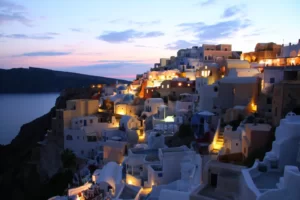
A reasonable level of fitness is required to climb Mount Kilimanjaro in the five to nine days it takes, and to descend without feeling as though the world is ending.
In essence, it depends on which Kilimanjaro route you choose, as they vary in terrain, length, and type of lodging and can also be influenced by season. The fastest ascent of Kilimanjaro, however, can be measured in hours from the gate (the starting point of each route) to the summit! However, it goes without saying that this is done by professional athletes who are extremely fit, crazily fit, and completely acclimated to their surroundings!
For the rest of us mere mortals then we’ll take the assumption that you’ll arrive into Tanzania and not be acclimatised to nearly 6000m (as the speed ascent athletes are). This means that you must climb gradually, which is good news for most people.
How Long Does a Climb of Kilimanjaro Take?
Ascend, summit, and descent all take a minimum of 7 days for us. The best amount of time to spend on each route is seven days on Machame or Lemosho (the latter can also be climbed over eight days), seven days on the Rongai, or nine days on the Northern Circuit, which provides plenty of time for acclimatization but isn’t always within budget.
Factors Affecting How Long It Takes to Climb Kilimanjaro

Kilimanjaro is a “walk-up” mountain, meaning there is no technical climbing involved. How well you adjust to the reduced oxygen at altitude will determine how long it takes you to reach the summit.
Simply put, a lack of acclimatization to the altitude is the primary cause of climbers’ failure to reach Kilimanjaro’s summit.
How much does reaching the summit matter to you? The main obstacle in your way is acclimatization if you’re serious about finishing the climb.
The good news is that taking it slow and gradually acclimating to the lack of oxygen will allow your body to recover.
The more days you spend on the mountain acclimatizing, the better your chances of reaching the top. The chances of climbing Kilimanjaro in less than 5 days are the lowest, and the chances of reaching the summit in 8 or 9 days are significantly higher.
A slow and steady ascent gives your body time to adjust to the altitude, and while physical fitness does not seem to have an effect on how well you acclimatize, you’ll build-in enough time for rest and recovery after the day’s hiking.
It is challenging to obtain up-to-date data from the Kilimanjaro National Park, but in 2006 estimates of the success rate based on the number of days spent on the mountain were evident. At that time:
- 27% of those who opted for the 5-day trek made it to the summit,
- 85% of trekkers who spent 8 days on their climb were successful.
Thanks to better trailhead guides, better equipment, and improved knowledge of how to successfully hike the trail, those statistics have undoubtedly improved since that time. However, they serve as a reminder to you of the value of taking your time while climbing the mountain.
A higher ability to adapt does not necessarily result from being very fit. Being physically fit will make the trekking easier, reduce fatigue and stress, but it won’t help you acclimatize.
Physical fitness won’t provide you with any protection against altitude sickness, claims Dr. Hackett of the Institute for Altitude Medicine. Sometimes, many young, fit people will push through the discomfort, ignoring important symptoms.
How Long Does It Take to Climb Mount Kilimanjaro on Each Route?
There are a total of six different routes you can use to climb Mount Kilimanjaro.
The Marangu or Umbwe Route is the quickest route to the summit. These routes can be completed in 5 days (but we don’t recommend it for most hikers).
The longer treks, including Lemosho, Machame, Rongai, and the Northern Circuit route, last 6–10 days.
There are a number of factors to take into account when choosing a longer route, but the main one is to give your body time to adjust to the altitude.
Unless you are extremely fit, covering the same amount of ground in a shorter amount of time can increase your risk of fatigue and injury and compromise your enjoyment of the environment.
Trekkers with flexible schedules are advised by Climbing Kilimanjaro to think about taking a longer route or planning one or two acclimatization days to have an easier time reaching the summit.
Each route is varied in the duration on the mountain, the types of accommodation, the level of difficulty, the type of scenery, and other factors.
The Main Routes on Kilimanjaro
A climb or trek to altitude should never be rushed, it should always have a slow pace, set by a good guide that knows what they are doing, and you should have a support team to encourage and assist you by providing good tents, great food and plenty of watchful eyes to ensure you’re doing as much as possible to look after yourself. People are frequently taken aback by the pace because it’s deliberately slow and more of a dander. Even though acclimatization is crucial, frequent walkers occasionally find slow walking to be quite challenging.
Kilimanjaro is an expensive peak to climb and mostly due to the permits; for a seven day / six-night climb, which includes National Park fees, camping fees and a rescue fee the fees alone come to just shy of $1000 (correct as of 2020) for a non-resident. Due to this, a lot of people try to climb in 5 or 6 days rather than the planned 7 or 8, in an effort to save money. This is because climbing takes a lot of money when you factor in the cost of good food, guides, porters, cooks, assistant cooks, transportation, hotels, etc. it is an expensive peak.
Dropping a day or two will lower the cost, but it will also decrease your chances of summiting because you won’t have as much time to acclimate as you would on a 7-day itinerary and because you’ll be traveling the same distance in less time and therefore be more exhausted.
It’s much preferable to choose a 7-day approach and reach the summit in excellent shape so that you can look down on the sea of clouds and the plains far below and enjoy it after having dreamed of climbing the peak, saved up for it, researched it, purchased equipment and flights, and trained. There is no point in failing to summit or reach it and feel terrible – looking only at your feet as you vomit with a massive throbbing headache – that is pointless. It would be much better to travel there, take your time, climb to the top, and then take it all in.
Routes Up Mount Kilimanjaro
There are seven different ascent routes up Mount Kilimanjaro, but the Marangu route is the simplest and best suited for beginners.
Marangu Route Aka the ‘Coca-Cola Route’
The Marangu route, also known as the ‘Coca-Cola’ route, is the classic route to the summit of Mount Kilimanjaro. There are no campsites along any other routes; only this one offers huts that resemble dormitories.
The Horombo Hut has 120 bunk beds, while Mandara and the Kibo Huts each have 60. Because it is the simplest path, this is the most popular route among trekkers and the one that has been used for the longest.
However, if you’re a seasoned trekker or physically prefer more adventure, you may also try the following routes:
Shira Route
Another approach to Mount Kilimanjaro is via the Shira route, which comes from the west. Nearly identical to Lemosho, but less developed, is this route.
Despite the variety and beauty of this route, the Lemosho route is suggested instead. This is because Shira’s starting location, which is accessible by car quickly and has a comparable high altitude, is high.
Lemosho Route
The Lemosho route is one of the fresher tracks on Mount Kilimanjaro, which begins in the west. Similar to the Machame route, this one also travels from Shira Ridge to Shira Plateau.
The best panoramic views of the mountain are provided by this route, which is regarded as the most beautiful of the Kilimanjaro courses. When comparing traffic, views, and success rate, it is the most evenly matched of all the trails.
Umbwe Route
The Umbwe route is a short, steep, and direct course to Kilimanjaro. The most difficult trail to Mount Kilimanjaro, it is regarded as being strenuous.
Additionally, it has a rapid ascent and lacks the necessary phases for acclimatization to high altitudes. The success rate and traffic on this route are low due to the difficulty of the route.
Rongai Route
The Rongai route is close to the Kenyan border and the only course coming from the north. Despite the fact that this trail is now well-traveled, it is still a great alternative for those who enjoy hiking in remote areas.
Northern Circuit Route
One of the newest and best-recommended approaches to Kilimajaro is the Northern Circuit. Kilimanjaro is approached from the west via this thrilling route. Unlike the majority of west-approaching paths, which follow the southern traverse, this trail circumnavigates the mountain by going around the seldom-used northern slopes.
Comparing all Mount Kilimanjaro courses, this one is the longest and takes nine days. It also has the highest success rates. The best acclimatization occurs during the days spent at 13,000 feet, which helps explain why this trail has the highest success rates.
The Truth About Success Rates
Some businesses boast that their overall summit success rates are over 90%. Advertisements from rival companies claim to have overall success rates of 95%, 98%, or even 100%. Someone will eventually claim to have a 150% success rate, it is only a matter of time. In reality, none of these numbers are possible based on statistics. Do not believe these claims!
Achieving those astronomically high success rates would be impossible to sustain for even a short period of time unless these outfitters are prescreening climbers, taking a very small number of climbers (less than 30) per year, or leading climbs only on 8-9 day routes. Every outfitter is aware of this, but regrettably, it appears that some don’t mind luring customers in with misleading or blatantly false claims.
Who is the Fastest Climber Up Kilimanjaro?

Karl Egloff, a Swiss-Ecuadorian, set the record for the most recent fastest climb in August 2014 with a time of just 6 hours, 56 minutes, and 24 seconds. He took the Umbwe Route and descended via Mweka.
Ascent and Descent Time
It takes around five to nine days using the longer route to reach The Uhuru Peak is the summit of Mount Kilimanjaro. The journey from the summit of Uhuru Peak to the finish line would take two days.
Depending on the route and experience, the descent could take up to five hours to get to the camp for an overnight stay and between four and six hours the next day.
Conclusion
Whichever route you choose, you will need to stay on the mountain for at least 6 to 8 days. There are numerous routes to choose from and a rigorous ascent process for Mount Kilimanjaro.








